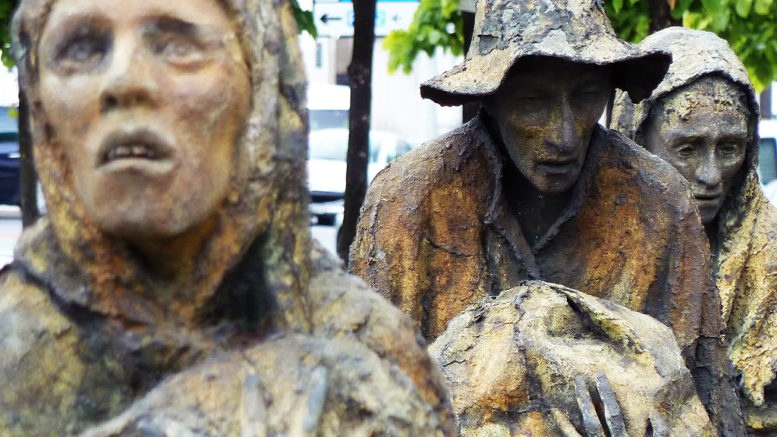We have all heard about the Irish potato famine, but not so many are aware that it was the result of Britain’s Irish policy favouring the landlords and not just about the spread of a fungus. The suffering caused was horrendous and the experience remains in the Irish memory. This article is from Sarah K Burns and was published by Raw Story (17 March 2017).
As many don green to celebrate St. Patrick’s Day, the truth about Irish-Americans has been lost to history books beyond the U.S. shores. Occasionally, a mention of the Potato Famine will surface, but high school textbooks neglect the heartbreaking pain and misery, not to mention deaths, of millions of Irish people that prompted them to migrate to American shores.
Former social studies teacher Bill Bigelow pointed out in Common Dreams that there’s no shortage of information and even study guides to teach students, yet the harrowing tales still remain untold. Bigelow cites flat mentions of the “horrible disaster” the famine caused, saying that they’re describing it as an earthquake or another natural disaster. Somehow it was nothing more than a blight.
Instead, textbooks are filled with only small slices of knowledge that are packed full of boredom, leaving any young person uninterested in searching for more information.
Bigelow suggests Thomas Gallagher’s Paddy’s Lament, which describes the first winter of the famine in which 400,000 Irish peasants starved while wealthy landlords scored millions from exporting food that could have saved them. There was an unbelievable amount of food produced in Ireland, Gallagher explained. Yet, it was all exported abroad.
The Potato Famine only happened to potatoes, prompting Bigelow to ask “why did people starve?” He urges teachers to ask students difficult questions about starvation amid surplus. Doing so can help youth to learn patterns in policy and about consequences of those actions that cut assistance to the poor, like President Donald Trump’s cuts to Meals on Wheels.
According to Bigelow, Raj Patel opens his book Stuffed and Starved: Markets, Power and the Hidden Battle for the World’s Food System by saying that the world produces more food than ever before. At the same time, more than one in 10 people are hungry.
“The hunger of 800 million happens at the same time as another historical first: that they are outnumbered by the one billion people on this planet who are overweight,” Patel wrote. He goes on to walk readers through the modern food system and the pattern of poverty and power playing out as it did during the Potato Famine.
Bigelow argues that corporate textbook producers aren’t interested in talking about inequality or highlighting global suffering of the poor.
Worldwide publishing company Pearson describes itself as focusing on earnings, cash and return on investment capital. Not education, information, learning, children or critical thinking. The company had $9 billion in sales in 2011.
There’s an alternative lesson that can help students investigate for themselves who was responsible for the deaths of so many Irish poor. There is plenty of blame to go around, however. It could have come from the wealthy landlords or the British who bought the food exports from Ireland. There is also the Anglican Church, which never denounced the wealthy causing the famine, as well.
Though, today, students are more likely to wear green


Be the first to comment on "The Irish potato famine was caused by wealthy landlords who prized profit over people and thousands starved"